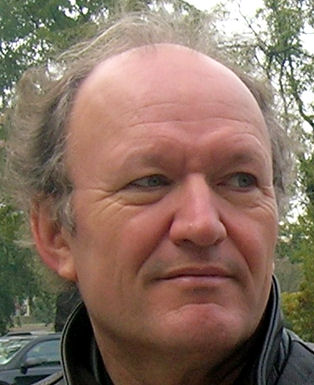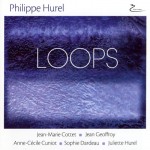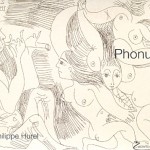Meeting Philippe Hurel

[Many thanks to Nigel Keay for proofreading]
I’ve been crossing paths with Philippe Hurel for several years now at contemporary music concerts, particularly those given by his excellent ensemble Court-circuit – Finally, we’ve found an opportunity to do a quick interview.
Style
TV : We’ve been a little hasty in classifying you as a spectral composer. Can you give us some indication of how your language has evolved?
PH : In fact my main influence has been structuralism, whether or not it was German or French. In terms of spectral music, I wrote an orchestral piece in 1982 that was close to this movement without knowing the music of Gérard Grisey or Tristan Murail. It was only later that I discovered Partiel by Grisey, and it was a real shock. I’ve always been attracted to the contrapuntal aspect in music, but, fascinated by harmonic relationships and instrumental fusion, I naturally turned towards spectral techniques. I was also influenced by jazz – in my youth I played guitar and electric violin with a jazz-rock group – but at the time there was a mistrust of pulse in the French contemporary music world, a mistrust of periodic rhythms in general, and what I’d call “a groove”. Besides, at that time in Paris, no-one played Reich nor any American repetitive music. It’s also amusing that there’s so much Boulez music which “pulsates,” even though he was a sworn opponent of pulse and « strong beat »
Over four or five years, I wrote rather “smooth” music, but then I thought that it was necessary to use everything we know. When I wrote the Six miniatures en trompe l’oeil in 1990-1991, a very structured piece but one where pulse has an important place, the response to the piece was very mixed. Pulsation is something that we have to win back again in France, when it’s already gained widespread acceptance in the United States.
Pour l’image (1985), which belongs to the spectral stream, is a piece that got me known. Even if this work already had, in a way, an underlying polyphony, I subsequently intensified this style of writing and introduced more discontinuity in the musical argument as opposed to the somewhat “smooth” side of my first pieces. I increasingly emphasised the melodic and polyphonic perception within a truly spectral harmonic discourse. On the surface these things are irreconcilable, but it was very exciting, a kind of gamble. It took me time, but Cantus for voice and ensemble (2006) is a good example of it. To be able to combine spectral verticality with counterpoint took me twenty years! Then came Loops, notably Loops III for flute, with an excessive development of repetition. Since the Traits cycle for violin and cello, I’m more interested in gesture and instrumental techniques.

At one point in my musical life, I decided to move away from contemporary techniques in my scores. From 86 onwards, when I wanted to make my instrumental music sound electronic, I tried to achieve this without using specific instrumental techniques, by simply using harmony and orchestration, without those techniques that tend to typify contemporary music and sound like clichés.
So, in the 90s, I found myself, along with composers Philippe Leroux, Magnus Lindberg, Kaija Saariaho, Luca Francesconi, Ivan Fedele, and many others, avoiding an excessive use of micro-intervals and contemporary techniques, to finally create a “cleaner” sort of music. And thus music has emerged that has brought rhythm back as a focus, as well as rapid transformative processes. In my works, we can see that in Pour Luigi, (1994) or …à mesure (1996) and in Philippe Leroux’s music, for example, in AAA which clearly has an American vision in his music. Finally I’ve paralleled some aspects of Reich’s music without knowing him: it’s been later that I’ve been in contact with him. But it’s normal that composers find similar solutions, even if that’s by different routes. Reich worked mainly on phasing or phase shifting through slow transformative processes; this is reminiscent of the spectral music world, although the results obtained are really quite different.
In reaction to the excessive clarity of our music, younger composers created hyper-saturated pieces, but they’ve notched that back a bit now. They’re also as dogmatic in their constant use of contemporary techniques as I could’ve been in refusing to use them. Dogmatism petrifies and it’s natural that I’ve reintroduced, over time, contemporary techniques in my music. In fact, throughout my career, I’ve realized that I’ve been slow to acquire freedom: it can take time to end up using means that may seem antithetical while being capable of living together.
TV : What will be the future Hurel ?
PH: No idea! What is certain is that I’m increasingly attracted to large-scale forms, long works, anyway I’m getting more and more commissions for big works. Something that haunts me is the fact that I’m now writing music that has a new form of consonance, and which also works with lighter, simpler objects, while making other parameters more complex. And no doubt also a greater exploration of what electronics can bring: instrumentally we’re going around in circles at the moment. I really want to go back to computing: recently I’ve composed mainly empirically, but I really do like the to and fro between theoretical reflection and composition.
TV : I tend to prefer works with real time computing than prerecorded ones?
PH: For me there’s no difference, it’s the result that counts! Just as Martin Matalon does, one tends to record the realtime results in the studio, it’s more convenient to transport … and I hate being exposed to the dangers of technology. There are drawbacks, however. For example, my Plein-jeu for accordion and electronics can sound realtime on first listening, but it remains somewhat fixed regardless of the performance. It’s a complex problem: I like realtime but it’s a little frustrating sometimes when compared with all that can be achieved in advance in the studio. Realtime is often less rich, but we profit from the interaction with the instruments, at least during the concert…
TV : What about computer in your composing process?
PH:I usually work out whatever is harmonic on computer, and for the rhythm, it depends on the pieces. Thus whole passages of Tour à tour were made by computer, much of Cantus also. On the other hand my cycle for violin and cello was handwritten, except harmonically..
TV : Aren’t you afraid of the progress of artificial intelligence, for example, the team which studied the works of Rembrandt then recreated one of his paintings in 3D printing? Imagine us studying the work of P. Hurel and recreating a new piece by him?
PH : Yan Marez at IRCAM created an impressive programme that enabled automatic music creation, but he never wanted to use it. I myself had written Trois études mécaniques, composed entirely by computer, but it’s very difficult to play, a little too stiff in formal terms also. There is only Mauro Lanza who manages to do it successfully, because he is a real computing “genius”. But until a computer can reproduce the music of a composer, there is still work to be done… The “exceptions” that a composer injects into his argument and syntax are always difficult to predict and formalize.
Preferred composers
The answer is immediate: Wagner! and, in Wagner, Parsifal! “It’s amusing too, that after the premiere of my Pigeons d’argile certain critics took one of my sentences out of context making it seem that the opera did not interest me! Then there is a plethora of composers! Beethoven, Stravinsky, Mahler, Bartók, Grisey, Ligeti, Purcell, Schumann, Murail, Mozart, Berg, Xenakis, Webern … the list is long … I came later to Debussy and Boulez. It was while listening to La mer one day on the radio in my car that I was finally and permanently affected by Debussy – and after having analysed his scores that had only allowed me to admire them! In fact, I have an extensive musical taste, and if I listen regularly to Mozart’s piano concertos, I also like the 3rd by Prokofiev and, I confess, I can entertain myself with a concerto by Rachmaninov.
Influences
They are more literary than pictorial. In contrast architecture has always stimulated me and given me ideas for writing. Perec, Proust, Simon, Joyce, Thomas Mann, Goethe, Diderot … these are authors whose “music” of the language and sense of form make me want to make music. The Magic Mountain for example gave me ideas on formal notions of anticipation, repetition, etc. Joyce of course! What I like about Perec is his ability to write highly profound and intellectual works while being simultaneously presented in a humorous way almost continuously – that false lightness is integrated into my way of thinking about music. I like to think that my music is not a downer for people while at the same time we also discern that it’s much more serious than we may believe. Phonus (2004) and Quatre Variations (2000) are pieces that appear lightweight, whereas they undoubtedly count among those in which I invested the most theoretically and technically. Finally these are accessible pieces without being easy, and I like that. This is where I feel close to Perec’s Disparition or Espèces d’espaces, which I set to music by the way (2011).
Preferred recordings
“I have almost no records at home anymore, I sold my LPs and copied my CDs onto my hard drive. There is one though (among others): the Fantasias for viols by Purcell with Jordi Savall and Hesperion XXI.
Teaching
I spend an exciting day each week at Lyon’s Conservatory. My role is not to produce “small Hurels” but to help my students find their own way with the best technique. Finally, it’s on problems concerning form that we spend the most time on, or instrumentation, instrumental feasibility, etc. The composition class is also a forum where music is not the only subject. Discussing arts, social and political context, and the different aspects of being a professional composer, all these are parts of what I wish to teach.
TV: What if a student presents you with a neo-tonal score?
PH: No risk, i select them…, but the partition may be consonant – which is not the same thing – and there, no problem!
Addressing his work

PH: Start perhaps with pieces that are somewhat substantial, Tour à tour III …à mesure, a very direct piece, Trait d’union too. Or more approachable pieces for a neophyte to contemporary music: Phonus for example. But it’s hard to say how to get into contemporary music: at 22, I found Jonchaies by Xenakis exciting, while Berg seemed very grey harmonically to me. Obviously I love Berg since. It’s like Boulez, I did not like the Marteau sans maître and then, when older, loved Pli selon pli.
TV: Denisov said “music has the ability to elevate the souls”?
PH: Developing spirit, sensitivity and reflection, I’m sure. As for “souls”, I do not know what that means; there are brilliant composers who’ve had a somewhat uneventful life emotionally and ethically. In composing, I feel that we create order where there is none, that we give others a certain order of the world, in the end the composer is more the intermediary than the demiurge.
Sometimes I put up little complex operations which are reorganized by themselves later without the score in some magical way, giving me the impression that there is something that works outside of us. Besides, if I do not feel that there is something beyond us, I would stop doing this job: it’s not money or popular success which make me advance!
Future
It is not joyful. The mainstream media dropped us a long time ago, and the lack of culture is gaining ground (the new Iphone is God today…), the disinterest of the State will increase. We already feel how the institutions are helpless and are increasingly seen promoting cross-over and mixed musical styles to flatter a public that’s been “dropped” for a long time, because of a lack of standards by the programmers. I fear that in the future we’ll move towards an American-style system and that contemporary music will be supported by educational institutions such as universities, for example, and that it will be ghettoized even more.
Another problem, and a major one, is that classical music is above all instrumentalists for whom 90% will have nothing to do with new music. Conservatories train a majority of instrumentalists who will never write music, when schools of architecture, by contrast, train people who will build (even badly sometimes, but that’s another discussion …). When I talk with architects, we discuss contemporary architects, Koolhaas, Piano, Herzog & de Meuron, etc. When I’m with instrumentalists, we usually talk about Beethoven, in the best case … Obviously I’m not talking here of the few musicians who fight for our music and who are admirable, both by their curiosity, their investment, and their musical level.
We cannot blame the public for not being convinced by our music when the musicians, conductors and singers responsible for playing it are not convinced themselves.
Many thanks to Philippe Hurel. Several of his works can be heard on Youtube.
